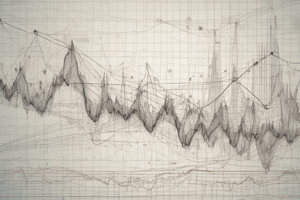Podcast
Questions and Answers
सांख्यिकी को क्या कहा जाता है?
सांख्यिकी को क्या कहा जाता है?
- गणना सांख्यिकी
- गणना का विज्ञान
- डेटा विश्लेषण का विज्ञान
- डेटा से सीखने का विज्ञान (correct)
क्या सही है कि सांख्यिकी के माध्यम से हमें क्या समझने में मदद मिलती है?
क्या सही है कि सांख्यिकी के माध्यम से हमें क्या समझने में मदद मिलती है?
- प्रतिष्ठात्मक संबंधों को (correct)
- समकल्पनात्मक संबंधों को
- प्रतिसंबंधी संपर्कों को
- कति-रूप विचारों को
नीलामी की नई रणनीति प्रभावकारी है - इस पर साबित करने के लिए हमें क्या करना चाहिए?
नीलामी की नई रणनीति प्रभावकारी है - इस पर साबित करने के लिए हमें क्या करना चाहिए?
- समुद्री प्रकल्प के साथ पहले-बाद में नीलामी
- निर्धारित उत्पादकता मापक प्रणाली
- कस्टमर फीडबैक लेना
- निरुपन से पहले-बाद में नीलामी के परिणामों का तुलनात्मक अनुक्रमण (correct)
सोशल साइंस, जैसे क्षेत्रों में, सांख्यिकी का उपयोग कैसे होता है?
सोशल साइंस, जैसे क्षेत्रों में, सांख्यिकी का उपयोग कैसे होता है?
कौन-सा क्षेत्र सहित, सांख्यिक मत्रों का महत्व हर बढ़ते हुए क्षेत्र में बढ़तता है?
कौन-सा क्षेत्र सहित, सांख्यिक मत्रों का महत्व हर बढ़ते हुए क्षेत्र में बढ़तता है?
किस क्रिया के माध्यम से निर्णय लेने की प्रक्रिया में आँकड़ाईकी तकनीकों से मूल्यवान अंमान्य में सहायता प्रदान कर सकती है?
किस क्रिया के माध्यम से निर्णय लेने की प्रक्रिया में आँकड़ाईकी तकनीकों से मूल्यवान अंमान्य में सहायता प्रदान कर सकती है?
किस शताब्दी में 'सांख्यिकी' का विकास हुआ था?
किस शताब्दी में 'सांख्यिकी' का विकास हुआ था?
'सांख्यिकी' के विकास में किस ने महत्वपूर्ण भूमिका निभाई थी?
'सांख्यिकी' के विकास में किस ने महत्वपूर्ण भूमिका निभाई थी?
'सांख्यिक सोच' किसके लिए महत्वपूर्ण है?
'सांख्यिक सोच' किसके लिए महत्वपूर्ण है?
'सांख्यिक' और 'गणन' के बीच कैसा संबंध है?
'सांख्यिक' और 'गणन' के बीच कैसा संबंध है?
Study Notes
Mathematics and Statistics
Mathematics is a broad field of study encompassing various disciplines such as algebra, geometry, calculus, number theory, and others. One area within mathematics that has grown significantly over the years is statistics, which deals with collecting, analyzing, interpreting, and presenting data. In this section, we will explore the relationship between mathematics and statistics, their applications, and how they have evolved together.
What Is Statistics?
Statistics is often referred to as the science of learning from data. It involves gathering information through observation or experimentation and using it to make decisions or predictions based on patterns observed in the data. This process can help people understand the underlying relationships and connections among variables. For example, if you wanted to know whether a new marketing strategy was effective, you could collect data on sales before and after implementing the strategy and compare them. By studying these results statistically, you might conclude that there's evidence supporting the effectiveness of your marketing efforts.
Applications of Statistics
The usefulness of statistical methods extends across numerous fields including business, finance, social sciences, medicine, biology, and beyond. As different areas grow more complex with large amounts of available data, our ability to model and analyze these situations becomes increasingly important.. When working with real-world problems where uncertainty and variability play significant roles, statistical techniques can offer valuable insights into decision-making processes.
Historical Perspective on Mathematics and Statistics
While the history of mathematics dates back thousands of years, its evolution towards modern mathematical practice began around the 7th century BCE, when Greek mathematicians developed many key concepts now considered foundational to both pure and applied mathematics. Over time, developments in probability theory and experimental design led to the emergence of what we now call 'statistics.'
In the late 19th and early 20th centuries, influential figures like Karl Pearson and Ronald Fisher played pivotal roles in shaping the discipline by introducing rigorous statistical methodologies to researchers across diverse scientific domains. Today, statistical thinking remains integral to guiding empirical inquiry and scientific progress worldwide.
Modern Trends in Mathematical Statistics
Recent advancements in computational power have allowed for more sophisticated modeling techniques such as machine learning algorithms. These advancements enable us to handle larger datasets and provide deeper understanding of phenomena through data analysis. Additionally, there is growing interest in certain branches of mathematics, particularly those related to computer programming languages and graph theory, reflecting society's increasing reliance upon technology for daily activities.
Conclusion
There exists a symbiotic relationship between mathematics and statistics; each supports the other while driving continuous innovation in problem solving approaches. Whether working directly in a technical capacity or applying principles learned through their studies elsewhere, graduates trained in these subjects enjoy versatility across sectors due to their skill sets being highly sought after across numerous industries and specializations.
Studying That Suits You
Use AI to generate personalized quizzes and flashcards to suit your learning preferences.
Description
Explore the intersection of mathematics and statistics, their applications, historical evolution, and modern trends in problem-solving approaches. Learn how statistical methods are used to analyze data and make informed decisions across various fields.




